JAZZ FROM HELL: THE SYNCLAVIER #1
In 1983 Zappa achieved a synthesizer that could play computer-programmed compositions, called
a synclavier. The synclavier provides means to execute high tempos and the constant repetition
of accompanying figures, which would become fatiguing to impossible for human players. Zappa in The real FZ book:
"Anything you make up, can be played or typed by the machine. One of the things I'm using it for,
is the creation of complex rhythms, that I can have executed accurately by different groups of
instruments. With the Synclavier you can have every imaginable group of instruments play
the most complex passages because the little fellows inside will always play it with a
millisecond precision degree... Some things live musicians do and machines don't are good
and some are bad. One of the good things live musicians do is improvise. They respond to the
moment, and can play with more expression than a machine. (Not that a machine knows no expression,
but I have to type in a lot of numbers to instantly get the same amount of expression as of a
well-rehearsed band)...Machines don't get drunk, stoned, or fired and don't need help
to carry their families with them from here to everywhere in cases of emergency."
The synclavier was first used for accompanying the spoken parts of "Thing-Fish". Next compositions performed on it
appeared on "The perfect stranger" and the 1985 release "FZ meets the mothers of prevention".
With the exception of one guitar solo the instrumental album "Jazz from hell" (1986) is all composed on the synclavier. The album makes full
use of the instrument to get perfect high tempo recordings of complex compositions. It's
the first one from three official CDs by Zappa himself with mainly synclavier music on it.
Additional material has been released by the ZFT.
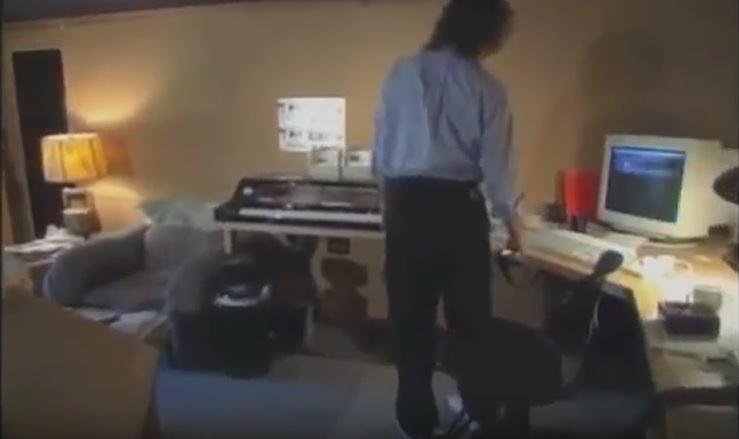

Two stills from the Ivo Niehe interview with Zappa, TROS television 1991. The synclavier was positioned in the studio area of Zappa's house,
where also the mixing panel stood. The room was called the Baby milk factory.
1. Night school
"Night school" from "Jazz from hell" has something of a written out improvisation, for it's an ongoing melodic movement
without returning themes. It's played over a repeated bass motif, sometimes interrupted for a bar to make change. The
section below is from the part where the motif is moving from C pedal to Ab pedal. The basic scale
is Lydian in both cases, though you have a lot of chromaticism going on. In the Ab pedal
part you for instance have the Ab and Ab augm. 5th chords alternating.
Night school, 2:47-3:16 (midi file).
Night school, 2:47-3:16 (transcription).
The subsequent pedal notes in "Night school" constitute the following modulation scheme:
- 0:00 Two bars with drums only.
- 0:07 C Lydian.
- 0:53 C# minor.
A chromatic element runs through much of this piece.
At 0:54 the melody plays the C# minor scale downwards, while the underlying
chord is the uncommon combination E-A#-D#, followed by E-F#-B-E (Esus2). You might call the A# a chromatic passing note in this context.
Or a mingling of minor with Dorian.
- 1:07 C Lydian.
- 2:02 C# major.
Night school, 2:00-2:23 (midi file).
Night school, 2:00-2:23 (transcription).
- 2:16 C# Dorian variant (with a major 7th).
- 2:22 C Lydian.
- 2:54 Ab Lydian.
- 3:21 G minor.
- 3:26 C Lydian.
- 4:11 F# pedal, semi-chromatic, semi-diatonic.
- 4:35 C Lydian.
- 4:50 End.
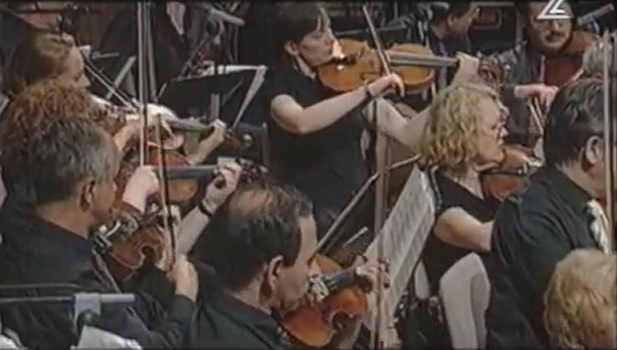 The title "Night school" refers to an idea Zappa had for a television program to discuss how news items can get edited. It's being
described in the Neil Slaven biography, chapter Once again, without the net.
Despite of all the new possibilities the instrument was giving him, the coming years saw a relative decrease in the flow of
new compositions and the accent shifted to the compiling of already recorded material. We'll
continue with the synclavier in the Civilization Phaze III and Dance me this sections. Night school has been orchestrated
and played by a couple of ensembles and orchestras, among others the Ensemble Modern. To my knowledge these re-arrangements weren't done by Zappa himself.
To the right a Youtube image from a 1997 performance during the Israel festival.
The title "Night school" refers to an idea Zappa had for a television program to discuss how news items can get edited. It's being
described in the Neil Slaven biography, chapter Once again, without the net.
Despite of all the new possibilities the instrument was giving him, the coming years saw a relative decrease in the flow of
new compositions and the accent shifted to the compiling of already recorded material. We'll
continue with the synclavier in the Civilization Phaze III and Dance me this sections. Night school has been orchestrated
and played by a couple of ensembles and orchestras, among others the Ensemble Modern. To my knowledge these re-arrangements weren't done by Zappa himself.
To the right a Youtube image from a 1997 performance during the Israel festival.
2. The Beltway bandits
"The Beltway bandits" begins suggesting a diatonic composition. You might call the G# the central note and, apart from some passing notes,
the chord formed is the G#sus4 chord. It's played in layers and built up irregularly. The piece begins with a bar in 11/16. Next the
example below continues in 10/16. It belongs to a group of compositions without clear downbeats. The meter notation is only there
as a time unit. It gives these pieces a certain charm of their own, making them sound as an ongoing stream. When you try to nod your head to it,
you'll find it won't work. This goes for several synclavier pieces, but there are also original compositions on paper where Zappa
keeps changing the meters all the time or where he's applying syncopes half of the time. In a practical audible sense, these
pieces get meterless: they are there on paper, but you can hardly experience them when only listening.
This goes for instance for "Igor's boogie" (changing meters) and "The perfect stranger" (syncopes). There are also some solos where
Zappa is playing without a rhythm section and not thinking about a meter. Any attempt to notate meters nevertheless in such cases
is technically possible but futile. It would get arbitrary, looking weird. Like Steve Vai in the FZ Guitar book, I prefer to
notate this as "no meter" rather than attempting some forced meter subdivisions. This is for instance happening during the opening of the "Yo' Mama"
solo and in part of the "Heidelberg" solo. In my "Heidelberg" example you can see that at some point Zappa starts playing in a recognizable
4/4 meter, a little before the rhythm section joins in. It's sort of a directing with a guitar instead of a baton.
The Beltway bandits, opening (midi file).
The Beltway bandits, opening (transcription).
I can't guarantee Zappa used 10/16 himself, but it's getting likely by the pattern of the repeating G# note in my staff 4. When
the lead melody enters the picture in bar 7, the first impression of a diatonic composition is swiftly diminishing. The accompaniment can sound
diatonic, but the lead melody is chromatic.
It's played by a number of instruments, for as far as you can call it that way on a synclavier. Rhythmically they are following
the same pattern, but the intervals between the notes vary all the time (with maybe some accent on thirds). So you're getting a sequence of chords as well, which
makes the overall sound a bit awkward and indefinable. In an article by Jeff Spurrier, called "Zappa on Jazz from hell", you can read Zappa's own comment, relating it to the so-called
Chord bible. See the L.S.O. section of this study for more about the Chord bible and a citation of Zappa's comment.
A similar situation exists for "Little beige sambo", where I'm explaining the definition difficulties for starting identifying such Chord bible chords, as:
- Should any sustained note be included in all vertical combinations? And sometimes it's hard to hear at what exact point a sustained note stops.
- Should little ornamental notes, like the ones from bar 8, staff 3, be included?
More importantly you would need the original score in this case. I can reasonably approach what's going on on the CD, but not to a degree where I feel certain
about each note involved.
Most synclavier pieces from "Jazz from hell" are humanly performable. For instance on the 4th and 6th of December 2003, the Asko Ensemble
played:
- Outrage at Valdez
- Outside now again
- Get whitey
- The Beltway bandits
- Night school
- Jazz from hell
- G-spot tornedo
The arrangements for this specific occasion were delivered by Ali Askin, Django Bates, Ron Ford and Corrie van Binsbergen. Some more details can be found at
https://www.united-mutations.com/a/asko_ensemble.htm.
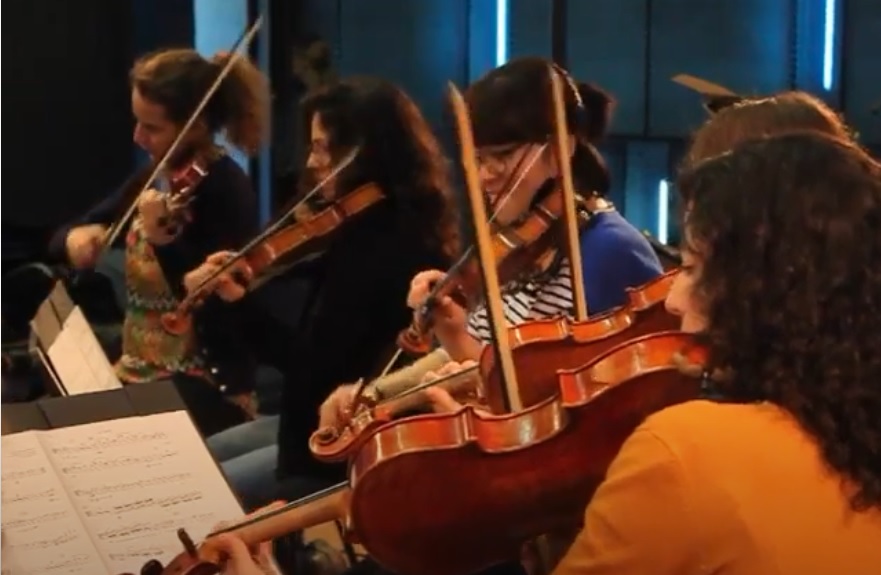
Members of the Amsterdam Conservatory rehearsing The Beltway bandits, November 7th, 2014 (YouTube, https://www.youtube.com/watch?v=VwBmJBCCtTw).
3. While you were art II
All synclavier music from "Jazz from hell" is based upon note entry, so the sheet music could be printed out from the machine.
The sound effects from "Massagio Galore" are probably the only exception, being overdubbed samples.
That scores indeed exist has been proven by the orchestrated versions that have been used by a couple of ensembles. At the
beginning of the Frank Scheffer documentary about Zappa you can briefly see an orchestra playing "Night school" (see my left menu,
miscellaneous items). A human performance of "The Beltway bandits" can be found on the "Greggery Peccary and other persuasions" CD by
the Ensemble modern. Best known is of course their "G-spot tornado" execution on "The yellow shark".
Zappa himself talks about this in the Real FZ book, chapter All about music. In the La machine section he notes that music could be typed
or played into the synclavier. So the synclavier supported some form of music notation. In the While you were art section he continues
with stating that one of the features of the machine was to facilitate that it could be printed out as score. He did this with
"While you were art II" for an ensemble assembled by Art Jarvinen.
They didn't succeed in playing it on short notice and decided to do a fake performance by playbacking it. Wires to amplifiers were attached to the
instruments to explain the more electronic sounds of the tape being played. Later on sampled examples of acoustic instruments were added
to the synclavier repertoire, so even that wouldn't be necessary anymore. In case of "Civilization phaze III" from 1994, with the Ensemble
Modern contributing, it became impossible to tell when humans or the synclavier is playing.
Zappa used the score of his "While you were out"
guitar solo as the starting point (see also the Shut up 'n play yer guitar section). This solo has been transcribed in full in the FZ Guitar book.
"While you were art II" is using diatonic material from different scales, mostly without clear tonics. At 3:47 an acceleration is taking place.
All is played by a number of instruments in a fragmented, hocketing way. It's energetic and emotionally touching with some
progressions sounding melancholic. Compared to the original solo this composition got thus thoroughly re-arranged that it gets
difficult to recognize the similarities when just listening. Replaying bars with the score on your desk makes it possible to detect
the notes from "While you were out", as I'm showing with the next fragments.
While you were art II, 0:11-0-15 (midi file).
While you were art II, fragments - While you were out, bars 5-11 (transcriptions).
- Snippet #1 (0:11-0:15): as you can see only the notes by Zappa's own guitar part are roughly recurring. The accompanying
chords by Warren aren't used. Instead you've got a pretty different arrangement. The returning notes are (F)-G-A and
B-A from bar 5 (the first F stems from bar 4). Straight from CD it's impossible to know what meters are used
during "While you were art II". So I've refrained from a meter notation, using only dashed lines for a better readability.
At this point there's a D pedal as in the original, so the key can be identified as D Dorian.
- Snippet #2 (0:17-0:20): several notes from bars 7-9 can be detected. It's played in a hocketing way.
- Snippet #3 (0:22-0:24): the descending D-C-G movement can be readily recognized, though also played an octave lower.
I've limited myself to only these fragments. I feel uncomfortable transcribing existing scores, especially really complex ones,
just because they are unavailable to private persons. On the other hand I can't omit them. It wouldn't do justice to Zappa
and give this study something of an incompleteness. So some examples are included, that are terrible to transcribe
directly from CD. When rhythms are getting as irregular as in this case, it's not even transcribing anymore in its standard meaning.
It's more like figuring out some sort of notation to get things even.
Below screenshots from www.pragueproms.cz, concerning a performance of Zappa's music by the Czech National Orchestra, June 2016.
The orchestra, assisted by former Zappa collaborators, was temporarily re-named as The Orchestra en Regalia. Sarah Hicks was conducting.
Notice the inclusion of "While you were art II". This is the first human performance of this composition.

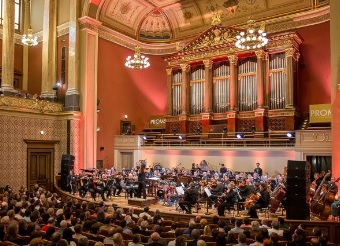
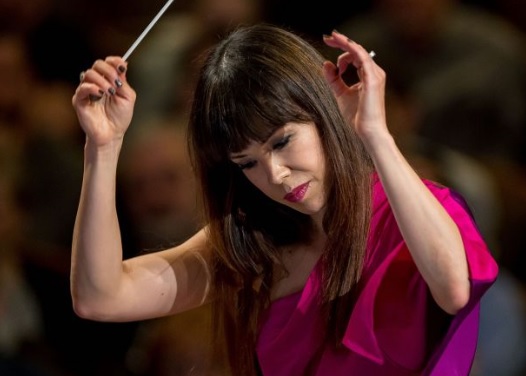
4. Jazz from hell
Of the three atonal/chromatic compositions on "Jazz from hell", the title track is the most complex one. To a degree Zappa here does try to let
the instruments sound as a jazz ensemble. There's an upright bass playing a counterpoint line and there are brass-like instruments. The other
synclavier pieces are using undefined computer-generated sounds.
Jazz from hell, 0:00-0:03 (midi file).
Jazz from hell, 0:00-0:03 (transcription).
Transcribing the "Jazz from hell" title track from the CD is hardly doable other than by approximation. Like the previous track, I would like to limit myself
to a snippet, the first three seconds from the opening. It has been performed by the Asko Ensemble, so a printed score must exist, making the effort of transcribing it pointless.
It's not in the current list of available scores at Schott Inc., nor have I encountered any example from it.
The meters in the snippet are my notational choice only. As more often in Zappa's synclavier compositions, the hocketing
writing style is directly recognizable.
In the "Greggery Peccary and other persuasions" CD liner notes, Gail Zappa tries to give some comment upon the title.
As usual rather cryptic. Some remarks by Zappa himself can be found in the Neil Slaven biography at the end
of chapter XIX. Though entirely instrumental, all titles of the tracks seem to refer to actual events as if Zappa wanted to say
something nevertheless. In case of "While you were art II" this reference is musical.
5. G-spot tornado (1986)
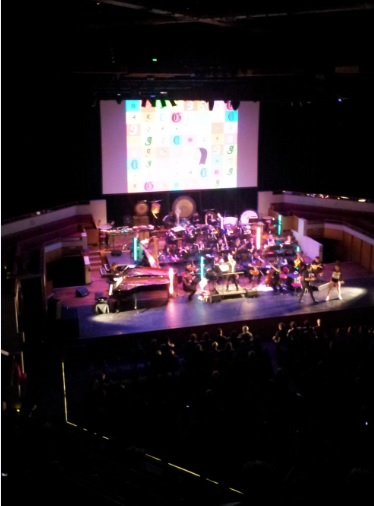 The following fragment is the opening from one of the albums more accessible pieces, G-spot tornado, that also has
been orchestrated to serve as the finale for "The yellow shark" (see the Counterpoint #2 section).
To the right the Ensemble Insomnio performing "G-spot tornado", including dancers (Vredenburg, Utrecht, 2-9-2019).
The following fragment is the opening from one of the albums more accessible pieces, G-spot tornado, that also has
been orchestrated to serve as the finale for "The yellow shark" (see the Counterpoint #2 section).
To the right the Ensemble Insomnio performing "G-spot tornado", including dancers (Vredenburg, Utrecht, 2-9-2019).
G-spot tornado, bars 2-6 (midi file).
G-spot tornado, 2:08-2:22 (midi file).
G-spot tornado, sections (notes).
This section is in B Dorian and harmonically basically regular. You could accompany it with for instance I 7th in the first bar, I 7th-II 5th-I 7th in the second bar etc.
The general structure of "G-spot tornado" is A-B-A. In A the main melody is played over a repeated bass
counterpoint melody (or extended vamp, or it's a passacaglia in baroque terms, if you like), B is the free
variation part and the theme returns at the end. The second example is from the middle B block, following all
harmonic formations, though using the notes of one scale. There are no clear key notes in this part. The bass is making an irregular quasi-improvised movement, using
G natural as opposed to the G sharp of the main melody. Because of the large register difference between the low G
of the bass and the descant melody, the dissonance effect of this difference isn't conspicuous. For the later "Yellow Shark" version this whole bass line from the middle
block eventually got left out. As it comes to sound, instrumentation and the human element, the "Yellow shark" version
is far richer. See "G-spot tornado (1992)" from the Yellow shark section for two examples from the 1992 version.
As a composition however, "G-spot tornado" is more articulate on "Jazz from hell", being a good example of the use of free counterpoint.
Both "G-spot tornado", at the period of the second example from above, and "Massagio Galore" offer many examples of Zappa applying fourths and fifths, as parallel chords or as melodic fragments with
these intervals stacked. In traditional harmony that's uncommon, in harmony classes even referred to as "errors". Zappa however liked such progressions and you can find many examples throughout his music,
but not in the sense that you might call them typically Zappa. It's just one of the many ways he looked for harmonic freedom.
G-spot tornado, 2nd example:
- Bars 1 and 5: stacked fourth (F#-B-E).
- Bar 2, beat 1: stacked fifth (G#-C#-F#-B).
- Bar 4: stacked fourths (G#-C#-F# and B-E-A).
- Bars 9-15: large series of parallel fourths.
Continued below at Massagio Galore.
6. Damp ankles
"Damp ankles" is an atonal composition
of the free kind. As "Night school" it has no thematic structure. It moves on slowly in many layers over an ongoing accompanying figure (the diminished 5th notes
from staff 3). Its beat is clear, the downbeats not. I've notated
4/4 in the example because it's the most common meter, but Zappa may very well have used other meters. It begins and ends with the sound of water waves
and seagulls, suggesting a naval environment.
Damp ankels, opening bars (midi file).
Damp ankles, opening (transcription).
In the mentioned article by Jeff Spurrier, Zappa comments: "Damp ankles is about two years old. It had been sitting around. I've got boxes of floppies with compositions that have
have been started and are in various stages of development I've had since I got the Synclavier. I don't work on one thing all the way
through. "Damp ankles" was the one I had the most trouble with because of the nature of the sounds that were in it. When it was originally typed in, we didn't have a velocity keyboard,
so I had to find a way to artificially impose dynamic information onto these sounds". What follows is pretty technical. Apparently the composition had no dynamics at first. A way
had to be found to add them by superimposing an auxiliary composition where the notes represented loudness instead of pitches with C2 being the quietest audible
level and C7 the loudest.
7. St. Etienne
 "St. Etienne" is the only humanly performed piece on "Jazz from hell", giving the whole an extra dimension. So the whole 1982 band can be credited as musicians on the CD,
otherwise and would have been Zappa only. It's a solo from the 1982 spring tour, simply named
after the venue, where it was recorded. It's a pedal note solo in B Dorian. Towards the end you can hear Zappa picking notes as fast as he can. He did something comparable during his
Budapest solo. See the Documentaries section for how this looks on paper.
"St. Etienne" is the only humanly performed piece on "Jazz from hell", giving the whole an extra dimension. So the whole 1982 band can be credited as musicians on the CD,
otherwise and would have been Zappa only. It's a solo from the 1982 spring tour, simply named
after the venue, where it was recorded. It's a pedal note solo in B Dorian. Towards the end you can hear Zappa picking notes as fast as he can. He did something comparable during his
Budapest solo. See the Documentaries section for how this looks on paper.
St. Etienne, 0:00-0:28 (midi file).
St. Etienne, 0:00-0:28 (transcription).
"St. Etienne" begins very calm in a relaxed tempo. Bars 1-2 contain what you might call a chord progression, Bm7-C#m-Bm-E-Bm (no 5th). Other parts may by extending these chords
to larger ones. The total you're hearing is rather mixed, achieved by band members improvising. From bar 3 onwards Zappa starts playing melodically, gentle at first and accelerating
in bar 9.
Above to the right: FZ playing "St. Etienne" in 1982, in this case sitting on a stool.
(still from the "Ein leben wie ein extravaganza" documentary by Rudi Dolezal and Hannes Rossacher).
8. Massagio Galore
Continuation of the above at G-spot tornado:
Massagio Galore:
- Bar 1, beat 4, of the vamp: upgoing series of fifths (C-G-D-A).
- Bar 2, beat 1, of the vamp: downgoing series of fifths (Bb-Eb-Ab-Db).
- Bars 2, 4, 6 and 8: fourths for the harmony.
- Bars 8-9: the lead melody begins with a series of stacked fourths (D-G-C-F).
Massagio Galore, opening (midi file).
Massagio Galore, opening (transcription).
"Massagio Galore", the closing track from "Jazz from hell", is made up of a two-bar vamp in G minor, over which a slow lead melody is played. The example
above shows the opening with the lead melody entering in bar 8. All through this track you've got various sound effects, that I've also included in
the transcription and, to a lesser degree, in the midi file. It's hard to simulate such effects in midi format. The stacking of fifths in the vamp
leads to two altered notes on beat 1 of bar 2, Ab and Db. If you would interpret this as a modulation, it would mean that you're here getting
at an obscure scale, namely G Locrian. The lead melody is hexatonic, using G-Bb-C-D-Eb-F. Only at the
very end you can hear an Ab passing by. With chromatic notes turning up in the "sound effects" staves,
there's some ambiguity about the scale being used. In his response to me, Brett Clement calls it G Phrygian,
which holds the middle between minor and Locrian. The A is first natural in bar 1 of the vamp and flat in bar 2, so
I consider calling it G minor more logical.
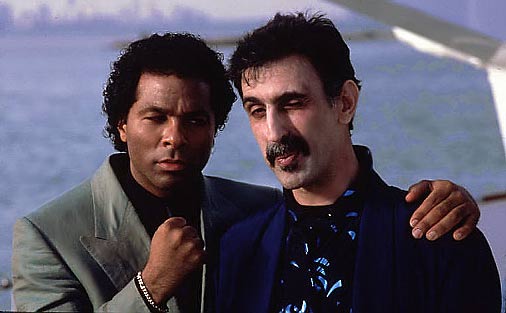 Zappa and Philip Michael Thomas. Source: NBC television, publicity photos.
Zappa and Philip Michael Thomas. Source: NBC television, publicity photos.
At the time of the "Jazz from hell" release in 1986 Zappa had a guest appearance in the Miami
Vice TV-series as the drug dealer Mario Fuentes. Fuentes was living on a boat just outside the
territorial waters of the U.S., so that he couldn't be taken into custody by the Miami Police.
A set up was constructed, where detective Crockett and an FBI agent could take action against
Fuentes (I don't recall what the idea behind it was). But on their way towards Fuentes' boat
Crockett found out that the FBI agent was corrupt and that the plot was actually against himself. He
just managed to shoot the agent before the agent could shoot him. That was the end of the episode.
The black page (1987)
In 1987 Zappa released some material as a bonus of magazines or in collaboration with magazines. About these releases Greg Russo writes:
"The January issue of Guitar Player Magazine featured a soundpage (also known as a "flexi") of the 1984 live track "Sharleena", on which Frank
and son Dweezil shared lead guitar responsibilities. A longer (and differently mixed) version of this performance of "Sharleena" surfaced on
the April 1988 "You can't do that on stage anymore sampler" and on the later 1989 release of "You can't do that on stage anymore vol. 3".
Keyboard Magazine's issue for February featured an interview with Zappa and his synclavier work, as well as another soundpage. The recording on
this occasion, a Synclavier version of "Black page no. 1", is exclusive to this soundpage. In June, Zappa released the cassette "The guitar
world according to Frank Zappa", in conjunction with with Guitar World magazine". The solos on it would later on be released on "Guitar" and
the ZFT production "One shot deal", though in different edits.

The black page #1, bars 5-10, as reproduced in Zappa in New York Deluxe (collection of Ruth Underwood).
The above handwritten lead sheet, as given to Ruth, shows the melody only. The 1976 score prescribes bass pedal notes with sus2-chords.
These bass notes set the scales to predominantly Lydian.
The harmony of the accompaniment thus isn't written out in detail and the actual "The black page #1 (1976)"
performance on "Zappa in New York"
contains an overdubbed part by Louanne Neil with harmonic fill-in on harp. See the corresponding section for more about this 1976 execution.
None of the "Black page" executions follow the sus-2 chords
consistently. The 1987 synclavier performance has obtained little attention, even though it's official material and its harmonies
shine a pretty different light upon this composition. In this case it's all typed in on the synclavier.
The black page #1 (1987), bars 5-6 (midi file).
The black page #1 (1987), bars 12-14 (midi file).
The black page #1 (1987), bars 5-6 (score/transcription).
The black page #1 (1987), bars 12-14 (score/transcription).
The two examples above are played between 0:16-0:21 and 0:44-0:56 on the flexi-single respectively.
In bar 5 you can see that staves 1 and 2 are playing in parallels. Staff 1 is the original score. Staff 2 creates parallels,
subsequently major thirds, minor thirds, unisono and fourths. Melodically you can also see that the last four notes of bar 5 are
stacking fourths. The 1976 score prescribes G2, suggesting G Lydian, though with the inclusion of many chromatic notes.
The 1987 execution has a B pedal, suggesting B minor at first. Staves 3 and 4 contain countermelodies. With their rhythm following
the lead melody, the overall effect is that they extend the harmonies to all kind of chord types. The idea of using sus-2 chords
is completely gone in this synclavier version, as well is the use of Lydian scales only left. During the second and third beat of the triplet, chromaticism
is getting the upper hand. Bar 5 is also an example of tuplets within tuplets. In this case a quintuplet and sextuplet within a triplet.
Quite specific for the 1987 version is the inclusion of a hocketing accompaniment for the notes, that are sustained.
This is happening during beat 1 of bar 6 and beats 1-2 of bar 12 in the examples above. The second example
with bars 12-14 confirm this picture. Again the lead melody is played in parallels (as is also happening occasionally during the 1976
performance). In the 1976 version these bars belong to the D2 part in D Lydian. If notes should be called tonics, it's
B in the second example above for bars 12-13 and D in bar 14. They suggest B Dorian and D Lydian respectively,
though again the chromatic element is significant.
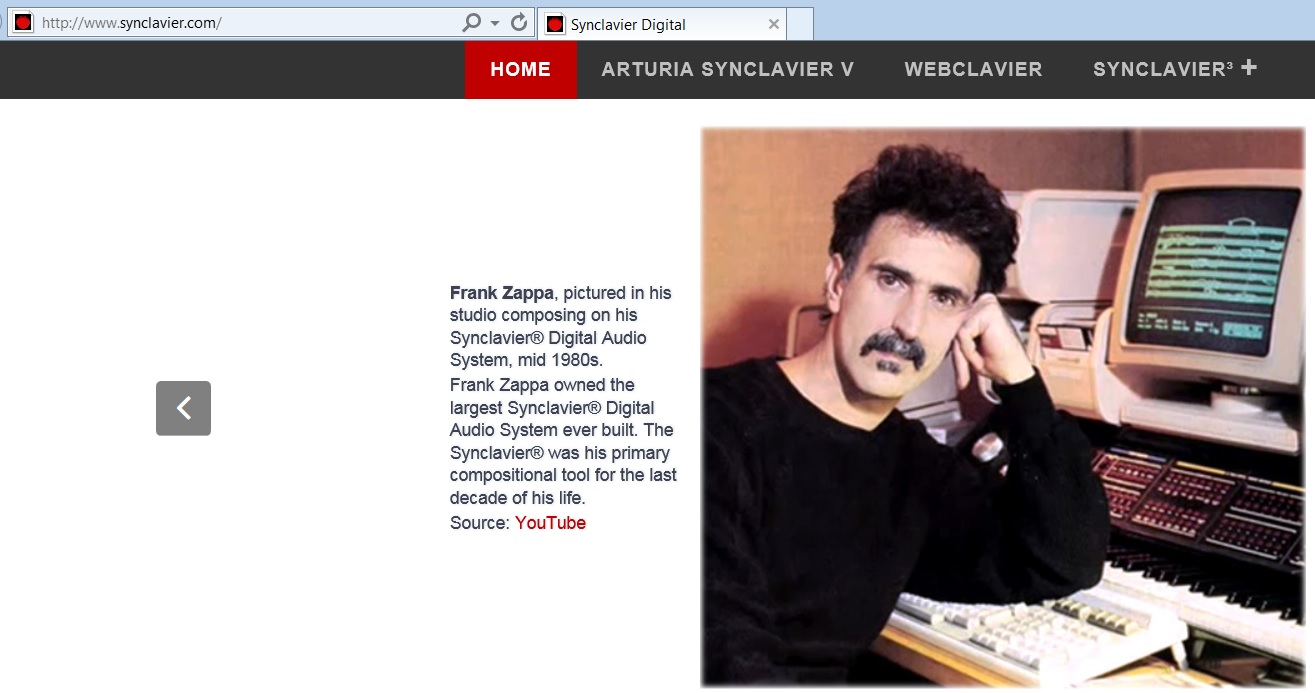
Screenshot from the www.synclavier.com site. The company is still active with newer versions of the synclavier on the market (situation in 2019). The one Zappa
owned still seems to be in possession of the ZFT, but inactive because of difficulties with finding people who know how to operate it.
On the screen you can vaguely recognize sheet music with a regular staves presentation.
Medieval ensemble
"Medieval ensemble" is a 1985 synclavier piece released by the ZFT on their "Frank Zappa for president" CD from 2016.
It's difficult music. It's through-composed, chromatic, and it knows a high degree of counterpoint. At first hearing it sounds
abstract and chaotic, but when listening more frequently it comes alive. You start hearing the variations of motifs and get used
to the presence of multiple melodic lines.
Medieval ensemble, 4:49-4:57 (midi file).
Medieval ensemble, 4:49-4:57 (approximation).
Possibly a print-out of this piece is present in the ZFT archives. The piece knows no downbeats or steady rhythms, thus being hardly fit for transcribing.
The above is an attempt to do a little with it, notated in 4/4, but it remains an approximation only. What you can see is the presence
of four melodic lines: by a horn, a flute, a snare instrument popping up in both corners of the stereo field, and a bassoon. Next you've got some
individual notes (staff 5) and a drum part, of which I've only indicated the beats. Applying counterpoint this extensively is unusual in Zappa's
music, so "Medieval ensemble" offers a relevant contribution to his output.
